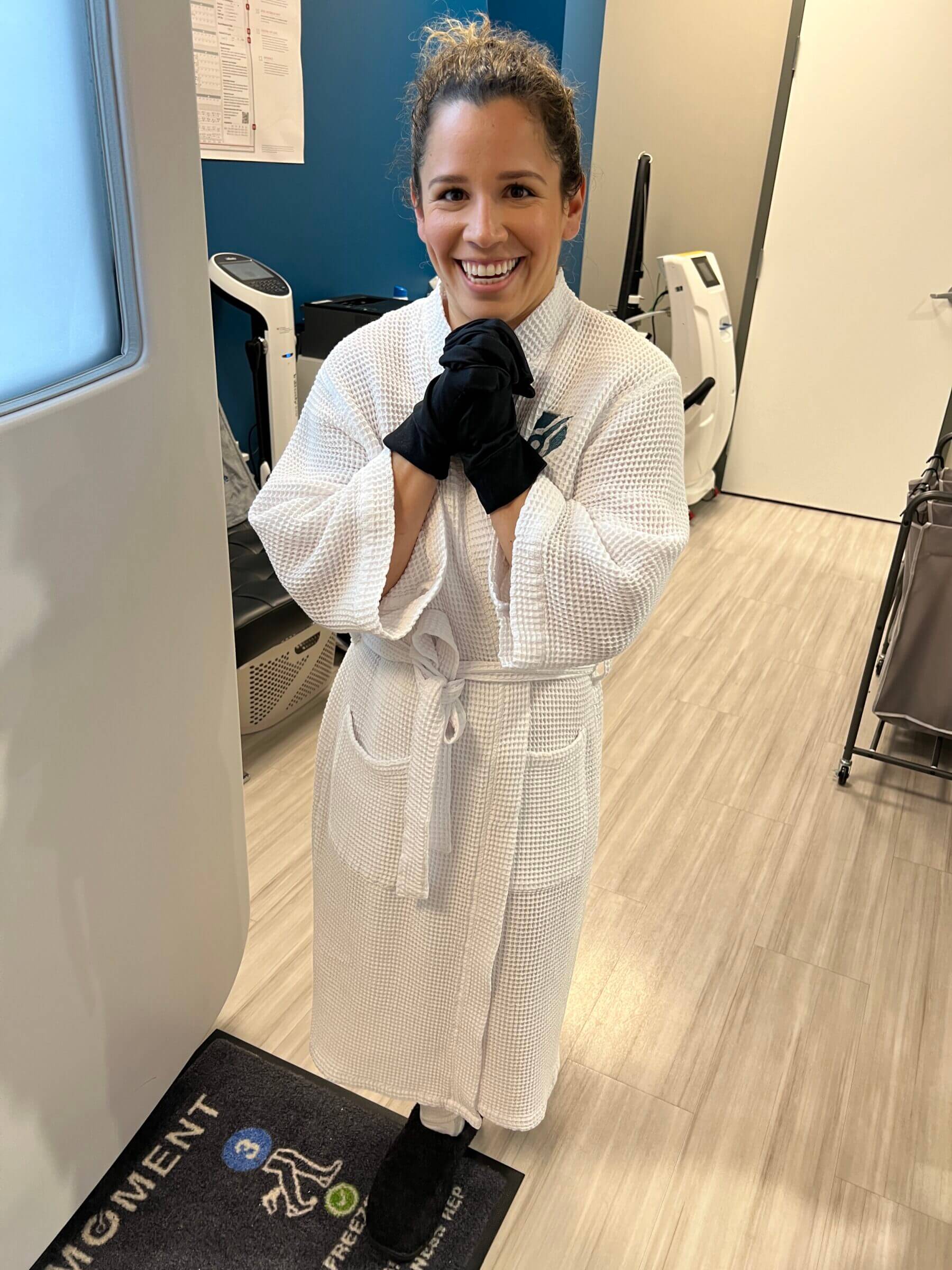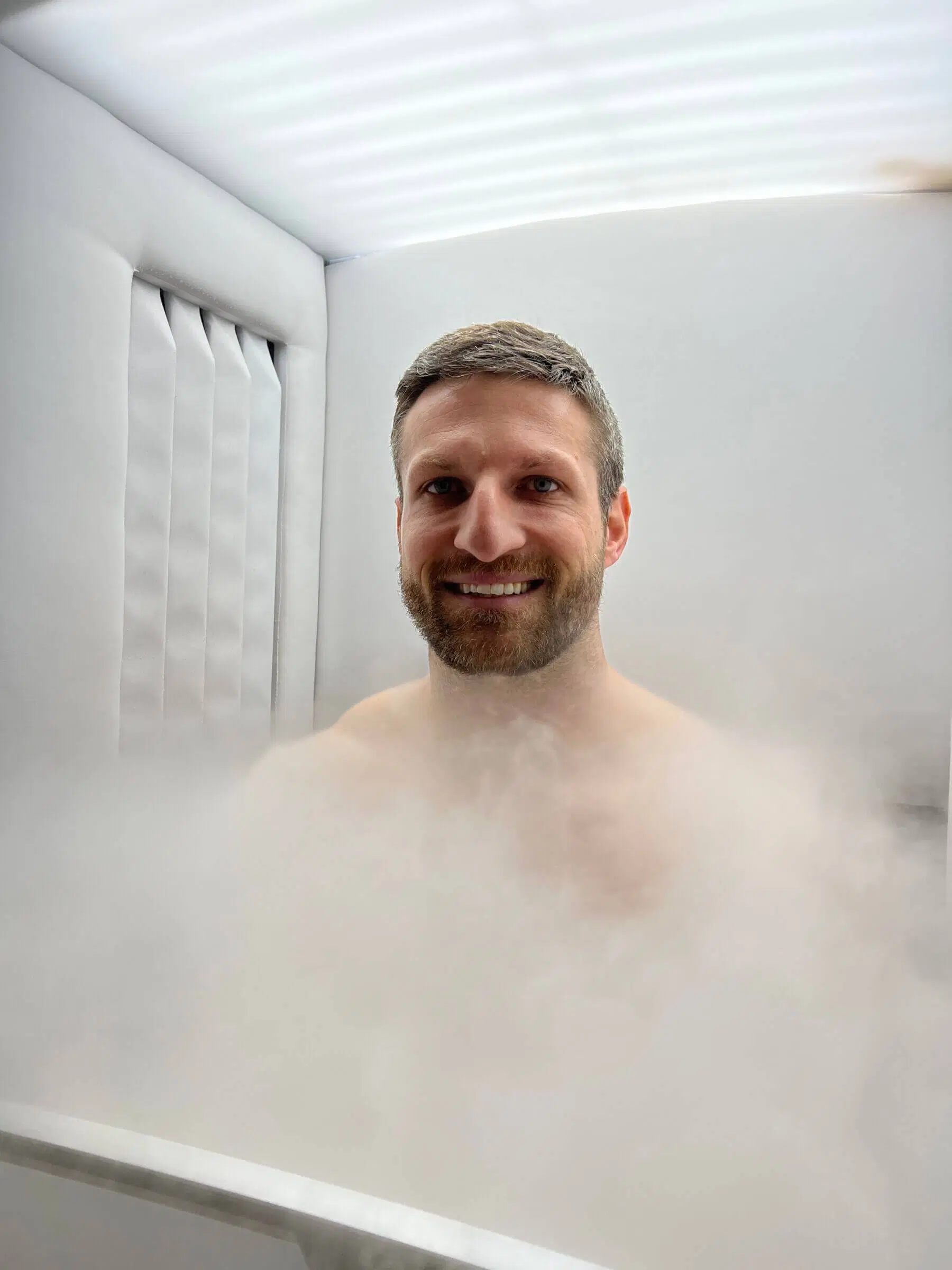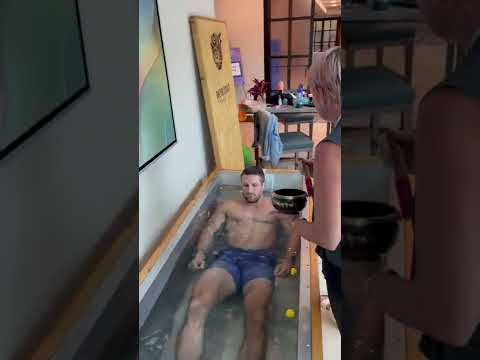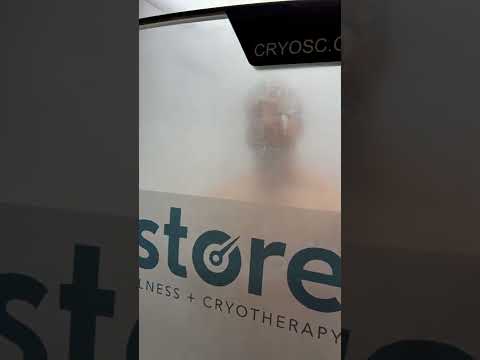After I took my first ice bath at a Biohacking conference in 2021, I started making cold plunging part of my daily wellness routine. A few months later, I began experimenting with cryotherapy in order to compare the benefits of the two methods side by side.
This article explains everything you need to know about the differences between ice baths and cryotherapy, so that you can decide which one is the better option based on your individual health goals and budget.
Note that this article focuses exclusively on whole-body cryotherapy — in which the entire body is exposed to extremely cold air for several minutes — as opposed to localized cryotherapy, which uses ice packs or ice crystals.
Localized cryotherapy is used to treat migraines and freeze cancer cells, but it doesn’t offer the same overall wellness benefits as whole-body cold therapy.
In a nutshell, both ice baths and whole-body cryotherapy offer several benefits, including:
- Boosts your mood.
- Numbs nerve irritation.
- Speeds up physical recovery.
- Helps burn fat.
- Balances your immune system.
- Offers neurocognitive benefits.
- Treats certain skin conditions.
To learn more about these benefits in greater detail, check out my article on the health benefits of ice baths and cold plunging.
Key Differences Between Ice Baths and Cryotherapy

Below are two tables that illustrate some of the key differences between ice baths and cryotherapy, including a side-by-side comparison of their benefits.
| Ice Bath | Cryotherapy | |
|---|---|---|
| Initial investment | ★★★☆ | N/A |
| Recurring costs | ★☆☆☆ | ★★★☆ |
| Time investment | ★★☆☆ | ★★★☆ |
| Safety | ★★★☆ | ★★★★ |
| Benefits | ★★★★ | ★★★☆ |
Doing cryotherapy usually involves driving to a wellness center and could require a significant time investment, depending on how close the nearest location is. We have a wellness center relatively close by, but I still have to invest an hour to drive there, check in, change into my underwear, spend a few minutes in the cryo chamber and come back home.
In comparison, jumping into my Plunge tub takes less than 10 minutes — unless I want to take a shower afterwards (which can help further improve blood flow).
From a safety perspective, I’d argue that cryotherapy is slightly safer because you’re under constant supervision. If you jump into an ice bath by yourself and pass out, you risk hypothermia or drowning. Of course, you can always recruit a family member to watch you while you’re in the cold water.
Benefits Comparison
| Ice Bath | Cryotherapy | |
|---|---|---|
| Improves mental strength | ★★★★ | N/A |
| Improves resilience | ★★★★ | N/A |
| Increases production of collagen | ★★★☆ | ★★★☆ |
| Speeds up muscle recovery | ★★★★ | ★☆☆☆ |
| Boosts mood and energy levels | ★★★★ | ★★★☆ |
| Improves cognition | ★★★★ | ★★★☆ |
| Balances immune system | ★★★★ | ★★☆☆ |
| Numbs nerve irritation | ★★★★ | ★★★☆ |
| Treats certain skin conditions | ★★★★ | ★★★☆ |
| Helps burn fat | ★★★★ | ★★★☆ |
Overall, I consider an ice bath or cold plunge to be cold therapy on steroids: it offers additional benefits compared to cryotherapy and enables you to reap the shared benefits faster.
What Does an Ice Bath Do?
When you submerge yourself in ice cold water — a process I’ll refer to as both ice bathing and cold plunging in this article — your sympathetic nervous system goes into overdrive, triggering a fight or flight response.
In other words, the initial shock of the cold water makes you want to get out of the tub immediately because your brain thinks you’re in a life-threatening situation. Of course, prolonged exposure to cold temperatures can cause hypothermia, shock and death, so your brain isn’t entirely wrong — it just doesn’t know that you’re choosing to expose yourself to cold water for a few minutes on purpose.
One of the best ways to calm down and downregulate your sympathetic nervous system is box breathing, a technique that involves slowing down your inhalations and exhalations with breath-holds in between. When done correctly, box breathing effectively tells your brain that you’re not in a life-threatening situation after all.
The initial shock response of being exposed to cold water causes the release of multifunctional RNA/DNA binding proteins, which have neuroprotective properties. Studies in mice have shown that those multifunctional proteins can prevent cell death in the brain and (potentially) prevent or treat neurological diseases, such as dementia or Alzheimer’s.
If you take ice baths on a regular basis, your body will adapt and you’ll become more resilient. It took me about five to six cold plunges to get used to the initial shock response. After that, jumping into freezing cold water wasn’t a big deal anymore.
Don’t get me wrong: exposing my entire body to ice cold water is still uncomfortable. It’s just that my brain isn’t freaking out anymore.
Another benefit of ice baths is that cold water is incredibly effective at quickly cooling down your skin and the outer layers of muscle tissue, thus causing your blood vessels to immediately constrict.
Paired with the increased blood flow in your extremities that occurs once you get out of the cold water, ice baths are an excellent way to improve recovery, lower inflammation, treat injuries and numb nerve irritation. That’s the reason why many professional athletes jump into an ice bath after an intense workout or competition.
Another seldomly talked-about benefit of ice bathing is that it increases vitamin A levels. Doing so supports the conversion of white to brown adipose tissue; while the former is considered “bad” fat, the latter stimulates fat burning and heat generation.
In other words, regular ice baths can help you lose weight in the form of fat.
For an ice bath to be effective, I recommend staying submerged (up to your chin) for two minutes to five minutes, or for as long as you feel is safe.
If you start shivering it’s time to get out.
Pros and Cons of Using an Ice Bath

Here’s a list of some of the pros and cons of ice baths.
Pros
- Improves your mood, mental strength and resilience.
- Speeds up physical recovery.
- Helps you better manage stress.
- Balances your immune system.
- Has neurocognitive benefits.
- Helps with weight loss by burning body fat.
Cons
- Initial investment in a cold plunge or ice barrel.
- Very uncomfortable at first.
- Temporarily increases blood pressure.
- Risk of hypothermia.
- Can cause temporary numbness, tingling and redness of the skin.
The most significant downside to ice baths is the initial investment: you have to either build or purchase a cold plunge tub or an ice barrel.
When I decided to incorporate ice baths into my daily routine, I researched all the possible options. Ultimately, I decided to invest in a tub aptly called The Plunge, because it fit in my budget and it required the least amount of time investment (i.e., water maintenance).
Check out my dedicated Plunge review to learn more about how it compares to DIY ice baths and more expensive ice bath alternatives.
Whole Body Cryotherapy: How It Works
Whole body cryotherapy involves sitting or standing in an enclosed chamber (called a cryochamber) that is filled with extremely cold air. The place I go to for cryotherapy uses liquid nitrogen to cool the air down to as cold as -225 Fahrenheit.
While that sounds incredibly cold, standing in a cryo chamber for three minutes is actually significantly more pleasant than being exposed to 39-degree water for the same duration.
There are a couple of reasons for that. For starters, the air in the cryo chamber gets cooled down gradually, so you don’t experience the same initial shock response as when plunging into an ice bath.
Second, cryotherapy leverages dry air. The lack of humidity prevents frostbite, but it also makes the air feel warmer than it actually is.
So while cryotherapy may not make you mentally stronger or more resilient, you can still reap the benefits I outlined at the beginning of this article — including a boost in mood and energy, neurocognitive improvements and increased blood flow — if you stay in the chamber for long enough.
Pros and Cons of Using Cryotherapy

Here’s a list of some of the pros and cons of cryotherapy.
Pros
- Not as mentally challenging as an ice bath.
- Offers scientifically-proven health benefits.
- No initial investment required.
- Increases collagen production.
- No ongoing maintenance.
Cons
- Doesn’t make you mentally stronger and more resilient.
- Treatment costs can add up quickly.
- Not ideal if you’re claustrophobic.
- You might experience difficulty breathing due to the fog.
The biggest benefits of cryotherapy are that you have no high initial cost to purchase equipment (unless you want to purchase your own cryotherapy chamber), and that it doesn’t require a lot of mental strength to step into the chamber.
Of course, I’d argue the latter is also a significant downside of cryotherapy, because you won’t get mentally stronger or become more resilient.
It’s also worth noting that enjoying regular cryotherapy isn’t cheap, and the costs can add up quickly. Owning a cold plunge is likely less expensive in the long run, despite the higher initial investment.
I’d also argue that you can achieve most of the health benefits of cold therapy more quickly by using an ice bath or cold plunge, simply because cold water immersion is much more intense and a greater “stressor” for the body. This is akin to comparing moderate-intensity and high-intensity workouts — you can get some of the same benefits from either workout routine, but you’ll get them much faster with high-intensity exercises.
Ice Bath vs Cryotherapy: Which One Is Better?
I had never experienced cryotherapy prior to writing my Plunge review. Fortunately, we have a wellness center nearby that offers a range of recovery regimes, including whole body cryotherapy.
So right before I finished up my review, I booked two sessions to see how it would feel compared to taking a cold plunge.
Before hopping into the cryotherapy chamber, I had a suspicion that enduring -220 degree cold (but dry) air wouldn’t be nearly as challenging as submerging your body into 39-degree water.
It turned out that I was right. The three minutes I was standing in the cryotherapy chamber in my underwear, socks, gloves and slippers (wearing those garments was a requirement) felt relatively pleasant, and there was no sign of a fight or flight response.
I could tell that I was getting cold towards the end of the session, but nowhere near the extent to which I feel cold after spending three minutes in a cold plunge. Also, with cryotherapy, you start feeling cold gradually, whereas jumping into cold water is an immediate shock to your system.
While I don’t think you’ll get mentally stronger by using cryotherapy, you can certainly get some of the same anti-inflammatory and vaso-constricting benefits if you spend enough time in the chamber. The ultimate goal, so I was told, is to reduce your skin temperature to about 45 degrees Fahrenheit to obtain the maximum benefits.
My skin temperature (as was measured on the lower part of my left calf) went down from 87 degrees to 60 degrees. In other words, the chamber wasn’t cold enough, and I didn’t stay in it long enough, for my skin to cool all the way down based on how my body is already adapted to handle cold therapy.
The technician operating the machine told me that I’d have to do two sessions back-to-back (for a total of six minutes of cold exposure) to cool my body down enough to reap the maximum benefits. Unfortunately, that would also mean that I’d have to pay for two sessions, making cryotherapy even more expensive than it already is.
Overall, I consider cryotherapy to be a light version of cold therapy that’s less intense than an ice bath or cold plunge while still delivering some (but not all) of the same benefits.
Specifically, cryotherapy may not help you get mentally stronger and more resilient because it’s relatively easy to endure (unless you’re incredibly sensitive to cold temperatures).
As far as pricing is concerned, paying for each cryotherapy session can add up quickly if you go several times a week (or if you have to do back-to-back sessions). I paid $34 for a single session at Restore, the wellness center I went to. The good news is that Restore offers an unlimited membership for $299 that allows you to use cryotherapy every day.
But even with such a membership, cryotherapy would be more expensive after just over a year in comparison to owning a cold plunge — not taking into account the time investment necessary to visit the center.
So you’ll have to do the math to see if it’s worth paying for cryotherapy versus investing in a cold plunge you can use every day from the comfort of your own home.
Frequently Asked Questions
Exposing yourself to extreme cold causes your body to release certain mood and energy-boosting hormones, including endorphins and norepinephrine.
Cold exposure reduces inflammation while improving antioxidant levels. Studies have shown that the combination of these factors can improve skin health, especially in patients who suffer from chronic inflammatory skin diseases such as atopic dermatitis.
Exposing sore muscles to ice water after an intense workout can help transport more nutrients to the affected areas, thus reducing soreness and speeding up recovery times. That’s why ice baths are a popular recovery method for elite athletes and fitness enthusiasts alike.
How long the effects of cryotherapy last depends on the benefit you’re looking at. The initial boost in mood and energy lasts several hours, and so does the increased metabolic rate as your body tries to warm back up to normal temperatures.
Some of the benefits that require repeat cold exposure (such as improved collagen production and skin health) last for longer, but they’ll likely fade if you stop the treatment — unless you also make other lifestyle changes (i.e., changing your diet) that reduce inflammation and promote collagen production.
Some cryotherapy providers claim that cryotherapy requires less time than ice baths. I think that’s plain wrong because two to three minutes in an ice bath cools your body down much more than spending the same amount of time in a cryo chamber. Plus, if you can purchase or build a cold plunge, you can take ice baths at home instead of having to drive to a cryotherapy facility.
The cold and dry air inside a cryo chamber penetrates the skin only about half a millimeter. That’s not enough to cause any meaningful changes in blood flow or tissue oxygenation inside of muscle tissue. So I don’t think that cryotherapy is an effective muscle recovery tool.
On the flip side, ice baths cause vasoconstriction (followed by vasodilation once you get out of the tub) deep inside the muscle tissue, thus helping the cardiovascular system to pump nutrients into the affected areas.
Ice Baths vs. Cryotherapy: Conclusion
Based on my research and personal experience with both ice baths and cryotherapy treatments, I think that submerging your entire body in ice cold water is the most effective form of cold therapy because it triggers an immediate fight or flight response that you’ll have to learn to control (e.g., by using breathing techniques).
In other words, taking a cold plunge on a daily basis requires you to be (or become) mentally strong, because every time you take a plunge your body (and mind) expect a sudden cold shock. So the more often you plunge into an ice bath, the more resilient and mentally tough you become.
However both of these cold therapy methods offer a slew of health benefits that should make them worth your consideration. Ultimately, the decision of which type of cold therapy is better for you depends on your financial situation and budget, your willingness to endure discomfort and your desire to improve your mental strength and resilience.
Investing in a cold plunge was the best choice for me considering my health goals and the expected return on investment over the next 12+ months.
Now I’d like to hear from you! Are you going to try cryotherapy or get an ice bath? Let me know in the comments below!

Michael is a healthy living enthusiast and CrossFit athlete whose goal is to help people achieve optimal health by bridging the gap between ancestral living and the demands of modern society.
Medical Disclaimer
The information shared on this blog is for educational purposes only, is not a substitute for the advice of medical doctors or registered dieticians (which we are not) and should not be used to prevent, diagnose, or treat any condition. Consult with a physician before starting a fitness regimen, adding supplements to your diet, or making other changes that may affect your medications, treatment plan or overall health. MichaelKummer.com and its owner MK Media Group, LLC are not liable for how you use and implement the information shared here, which is based on the opinions of the authors formed after engaging in personal use and research. We recommend products, services, or programs and are sometimes compensated for doing so as affiliates. Please read our Terms and Conditions for further information, including our privacy policy.



I love the article, but disagree that cryotherapy does not require mental resilience. The first time I did cryotherapy I couldn’t get past two minutes. It took a few tries to get to the three minute limit imposed by the cryotherapy center (they will allow up to five minutes if you are a regular and sign a waiver). I also doubled up on some days, with a pair of three minute sessions, allowing for my body to warm back up in between. I could not do that the first time I tried it. It took a few tires. Maybe that’s just me.
I do think cold plunges are an overall a better choice. 40° ice water seems far colder than -220° air/gas. And to be honest, I’ve never made it past two minutes in a cold plunge. That’s how tough I ain’t.
Hey Geno!
Thanks for the feedback, I appreciate it. I supposed everyone handles cold exposure differently. My statement was based on my wife’s experience who tried our cold plunge once and got out within 10 seconds. Cryo wasn’t an issue for her.
Cheers,
Michael
Great article – is a product like the cold plunge safe for generally healthy people older age groups – in their 60’s and 70’s?
Thanks, Rick! I see no reason why the Cold Plunge wouldn’t be safe for older age groups!